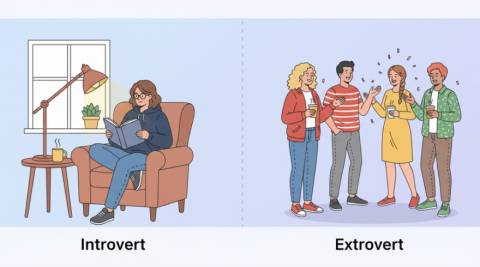Complete Guide to Understanding the Introversion–Extraversion Spectrum

What This Spectrum Measures and Why It Matters
People vary widely in how they recharge, communicate, and process stimulation, and those differences show up most clearly along a continuum rather than a strict either/or. Instead of labeling yourself permanently, it’s more helpful to see patterns that appear across settings like work, social gatherings, and recovery time. When you evaluate these patterns with intention, you gain language for needs that were previously hard to articulate, and that language can reduce friction in teams, families, and friendships.
Many readers explore an introvert or extrovert test to map where their energy preferences land across everyday contexts and time horizons. Beyond curiosity, the practical value shows up in better calendar design, smarter collaboration agreements, and a healthier balance between stimulation and solitude. Some people realize they’re not shy; they’re selectively social, and once that nuance is clear, they can choose environments that fit. Others learn that they thrive on quick feedback loops and group momentum, which changes how they plan projects and downtime.
For focused insight into reflective tendencies, some prefer a targeted introvert test that homes in on quiet-time needs and sensory thresholds without conflating them with social skill. While no single quiz defines your whole personality, a well-constructed assessment can highlight recurrent patterns and blind spots you can test in real life. After all, durable change comes from experiments, not from labels, and a good report suggests concrete experiments to try this week.
- Use assessments as mirrors, not verdicts, and compare results with lived experience.
- Track energy before and after activities to validate the patterns you discover.
- Share highlights with trusted partners to set expectations and boundaries.
The Science Behind the Continuum and Common Misconceptions
Psychology frames this terrain as a measurable orientation toward stimulation, with differences in baseline arousal, dopamine sensitivity, and attentional breadth. Rather than treating these tendencies as immutable, contemporary models view them as predispositions influenced by context, sleep, nutrition, and skills like emotional regulation. That’s why your results may shift subtly across seasons or roles, even though a core pattern often persists.
In research and coaching, a comparative introvert vs extrovert test may emphasize activation versus inhibition, social reward processing, and recovery time after intense engagement. When you understand those variables, you can stop pathologizing your natural rhythm and instead engineer conditions that let it flourish. Another modern approach counters the false binary by mapping gradients and situational variability. This perspective matters because many people blend traits fluidly, depending on stakes, audience, and stakes again.
To honor that nuance, a balanced introvert extrovert ambivert test acknowledges that you might lead brainstorms on Monday and crave deep solo work on Tuesday, with both modes being authentic. Tools that measure context, intensity, and frequency capture the dynamic quality of real life better than rigid labels. That means your best action plan will mix stimuli, buffers, and recovery loops tailored to your week’s demands.
- Beware quizzes that conflate sociability with confidence or communication skill.
- Look for items that ask about recovery needs, not just group size preferences.
- Treat scores as starting points, then iterate with deliberate lifestyle tweaks.
Benefits for Career, Learning, and Relationships
When you align tasks with your energy profile, productivity climbs without burnout, because you’re working with your nervous system rather than against it. Managers can time brainstorming for collective energy peaks and reserve afternoons for focus sprints that respect cognitive bandwidth. Educators can structure classrooms with varied participation formats, allowing reflective voices to prepare and expressive voices to improvise.
Career coaches sometimes recommend an extrovert introvert test before a role change, so candidates can forecast how client-facing cycles or solitary analysis might feel week to week. That foresight translates into better fit and less attrition, especially in hybrid or remote setups where boundaries blur easily. Couples and roommates can also use results to negotiate hosting frequency, quiet hours, and recovery rituals after big events. The goal is not uniformity but complementary rhythms that reduce friction.
In community settings, an introversion extroversion test can highlight how volunteers prefer to contribute, whether by greeting crowds, moderating chats, or crafting long-form materials behind the scenes. Teams that honor those preferences often see faster onboarding and greater retention, because people spend more time in their lanes of strength. The compounding effect is calmer calendars, sustainable output, and less resentment about mismatched expectations.
- Schedule deep work when your stimulation threshold is lowest to preserve focus.
- Batch social tasks near natural energy highs to harness momentum.
- Design recovery rituals after intense events to prevent overstimulation hangovers.
How to Take, Interpret, and Apply Results
Good instruments are transparent about what they measure, how they score, and which limitations exist, so you can interpret results without overreach. Before you invest time, scan for psychometric notes, clear item wording, and a nonjudgmental tone that frames outcomes as preferences rather than virtues. Context always matters here, because career phase, culture, and health can tilt responses, sometimes in opposite directions.
Before you click start, a personality test introvert extrovert should explain how it translates item responses into score bands and what practical steps follow. You’ll get more value if the report pairs insights with experiments, such as calendar audits or communication scripts you can test next week. When the output highlights gradients across domains, you can tailor actions to meetings, creative production, and social recovery separately rather than applying a blunt rule.
When reports plot scores across multiple bands, an introvert ambivert extrovert test may organize recommendations by energy source, social cadence, and recovery strategies so you know where to begin. Use that structure to build a personal playbook: timeboxing, sensory adjustments, and boundary statements that fit your load. The matrix below summarizes common patterns and immediate tactics you can try today.
| Signal You Notice | Likely Need | Action You Can Take |
|---|---|---|
| Mind feels foggy after long meetings | Reduced stimulation and quiet consolidation | Schedule a 20-minute decompression block before deep work |
| Energy spikes when collaborating live | Frequent feedback and social momentum | Stack short co-working sessions at the start of creative sprints |
| Alertness drops in noisy environments | Controlled sensory input | Use noise filters, softer lighting, and notification batching |
| Restlessness during solo stretches | Periodic interpersonal engagement | Insert check-ins or standups every 90–120 minutes |
- Pair insights with micro-experiments and measure changes in energy and output.
- Share a one-page playbook with colleagues to align meeting formats and timing.
- Revisit results quarterly, especially after big routine shifts or new roles.
Choosing Tools, Data Ethics, and Long-Term Fit
The best assessments respect privacy and provide practical value without trapping you in stereotypes, which means they should disclose data handling clearly and avoid reductive language. Go beyond flashy visuals and look for actionable guidance, because the usefulness of any report lives in the follow-through. If you’re implementing this in a team, pilot with volunteers, gather feedback, and set norms for respectful conversation about differences.
If you value discretion and depth, an introvert personality test should describe anonymization practices, retention windows, and whether third parties ever see your responses. Transparency lets you decide how to share results at work or keep them private until you’re ready. Budget also matters, because feature sets vary widely and you may not need enterprise analytics for personal exploration. Rather than guess, compare free and paid options across the dimensions you care about most.
Cost-conscious readers can start with an introvert extrovert test free to sample item quality and report clarity before upgrading to a richer interpretation. That trial run helps you judge tone, specificity, and the usefulness of recommended actions without risk. Over the long run, the right tool is the one you’ll actually use, because consistent reflection beats one-off curiosity every time.
- Check for constructive, nonjudgmental language throughout the report.
- Prefer tools that recommend specific, testable behaviors over vague traits.
- Document what works in a living playbook, and prune tactics that don’t help.
FAQ: Common Questions About This Kind of Assessment
How accurate are these assessments?
Accuracy varies with question quality, sample size used during validation, and how honestly you respond under typical conditions rather than extreme days. For a rounded view, pair results with a short observation period so you can confirm whether suggestions hold up in your real routines.
Can I use results to guide career choices?
Yes, but treat them as one input among many, alongside strengths, values, and preferred work environments. For roles heavy on client interaction and live collaboration, some managers also reference an extrovert personality test to balance teams thoughtfully.
Will my orientation change over time?
Core tendencies stay relatively stable, yet context and skills can shift how they show up day to day. After major life events, it’s wise to retake a reputable instrument and compare patterns rather than fixating on a single snapshot.
How do these tools differ from clinical diagnostics?
They explore normal-range preferences and energy dynamics, not mental health conditions. If distress is significant or persistent, consult a licensed professional who can provide assessment and care beyond the scope of self-report inventories.
What’s the role of scales and scoring bands?
Scales translate responses into interpretable ranges so you can see where you lean and how strongly that preference appears. For more nuance across intensity levels, some readers appreciate an introversion-extroversion scale test that reveals subtle gradients rather than binary categories.
Latest News



